Fiddler on the roof is a musical I consider a vertebra in the backbone of my childhood viewing, both the movie and the stage production. As I left Ebertfest in order to attend Parkland’s current production, directed by Stephen Fiol, it raised questions about film vs. live theatre and the particular truth of each. I came away thinking that it’s the audience members who prefer the comfort of repeated film viewings that may appreciate this particular production.
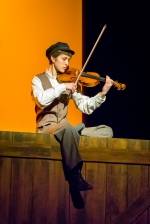 The advantage of re-watching a film is that the actor always delivers exactly the same performance: every reaction is as realistic and natural as the first time it was screened, offering opportunities to further analyze the plot and catch details you missed before. In the theatre, the advantage is that every performance is different, and every character in every play is portrayed differently by every actor. Both character and actor change the other in miniscule ways, marrying to find the harmony in the relationship between the two. It makes re-watching live productions more enticing, because I want to see what new truths an actor has to reveal about something that already feels familiar to me.
The advantage of re-watching a film is that the actor always delivers exactly the same performance: every reaction is as realistic and natural as the first time it was screened, offering opportunities to further analyze the plot and catch details you missed before. In the theatre, the advantage is that every performance is different, and every character in every play is portrayed differently by every actor. Both character and actor change the other in miniscule ways, marrying to find the harmony in the relationship between the two. It makes re-watching live productions more enticing, because I want to see what new truths an actor has to reveal about something that already feels familiar to me.
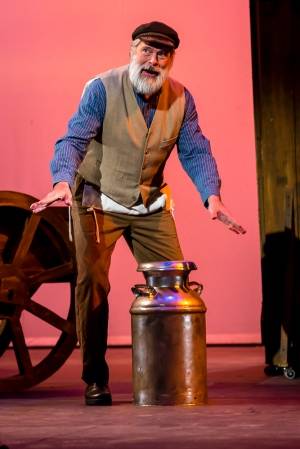 Familiar is exactly what I felt as Tevye entered with his cart to deliver his opening monologue. Lou Kinnamon did certainly look the part, with a natural beard and beautifully suited costume. As he spoke, I was immediately reminded of Topol, with a similar cadence and dialect being delivered, complete with gutturals and rolled r’s. His voice squeaked in a similar pitch, with predictable pauses and recognizable facial expressions and bodily gestures. Before the chorus could break out into “Tradition,” I had a feeling that I was in for a traditional performance.
Familiar is exactly what I felt as Tevye entered with his cart to deliver his opening monologue. Lou Kinnamon did certainly look the part, with a natural beard and beautifully suited costume. As he spoke, I was immediately reminded of Topol, with a similar cadence and dialect being delivered, complete with gutturals and rolled r’s. His voice squeaked in a similar pitch, with predictable pauses and recognizable facial expressions and bodily gestures. Before the chorus could break out into “Tradition,” I had a feeling that I was in for a traditional performance.
The impression continued throughout the show: lines and reactions were anticipated, worn-in; poses were practiced and the gestures were rote. It was clearly an enjoyable performance, with the audience laughing in the right places, and the actor knew the laugh was coming, so no lines got stepped on. But I felt like I was watching an impersonation of someone playing Tevye, instead of watching a dairyman struggle with impossible challenges resulting from a changing world. It was no surprise to 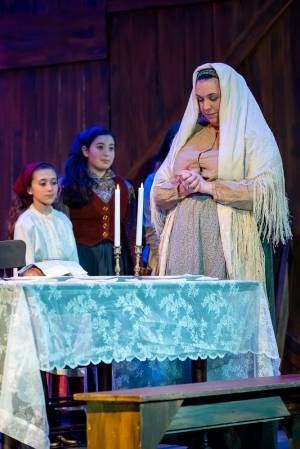 discover that this is the actor’s 5th time in the role; clearly the relationship between Tevye and Kinnamon was familiar in the way of old marrieds who have heard each other’s stories so often that they’ve forgotten whose is whose.
discover that this is the actor’s 5th time in the role; clearly the relationship between Tevye and Kinnamon was familiar in the way of old marrieds who have heard each other’s stories so often that they’ve forgotten whose is whose.
Which brings me to Golde, and the admirable portrayal by Jenny Gleason. With a strong voice and expressive eyes, Gleason’s Golde met her life’s changes and hardships with believable reactions and a large dose of affection for her children. While the usual depictions of this beleaguered character tend towards gruffness, the actress’ comedic background brought a little light into this performance, and humanized the huge amounts of irritation the wife demonstrates during her time onstage.
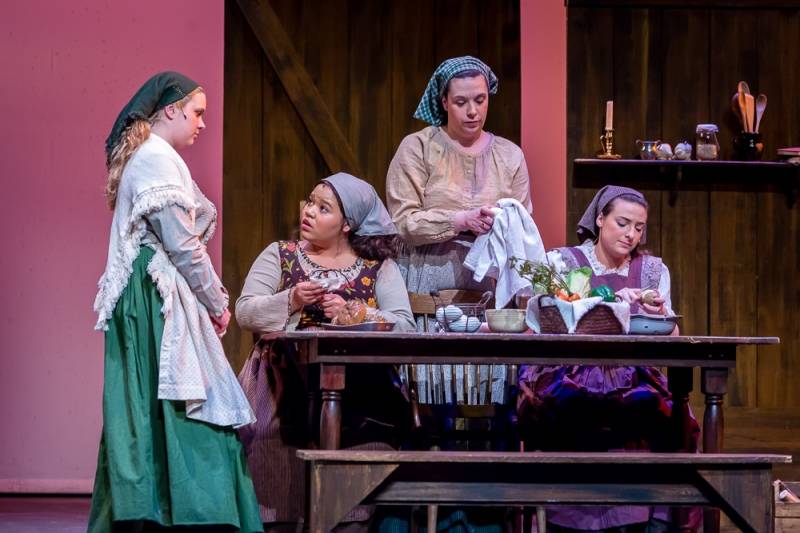
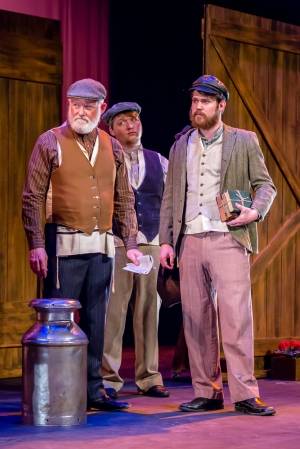 The daughters and their betrotheds were also sparks of relief sprinkled throughout, especially the pairing of Tafadzwa Diener’s Hodel and Warren Garver’s Perchik. Each actor separately was able to make their deliveries fresh and honest, and together the relationship was earnest. Motel the Tailor was another bright point, maturing his character through the play and delivering a lovely solo during “Miracle of Miracles.” Tafadzwa’s voice was a standout among the cast, strong and tuneful; my jaw dropped to hear Jeff Dare’s blessing as Fyedka during “To Life;” and Lazar Wolf surprised with his beautifully deep bass during “Anatevka.” Unfortunately, that bass range was stretched during “To Life”, where both he & Tevye had pitch and pronunciation issues.
The daughters and their betrotheds were also sparks of relief sprinkled throughout, especially the pairing of Tafadzwa Diener’s Hodel and Warren Garver’s Perchik. Each actor separately was able to make their deliveries fresh and honest, and together the relationship was earnest. Motel the Tailor was another bright point, maturing his character through the play and delivering a lovely solo during “Miracle of Miracles.” Tafadzwa’s voice was a standout among the cast, strong and tuneful; my jaw dropped to hear Jeff Dare’s blessing as Fyedka during “To Life;” and Lazar Wolf surprised with his beautifully deep bass during “Anatevka.” Unfortunately, that bass range was stretched during “To Life”, where both he & Tevye had pitch and pronunciation issues.
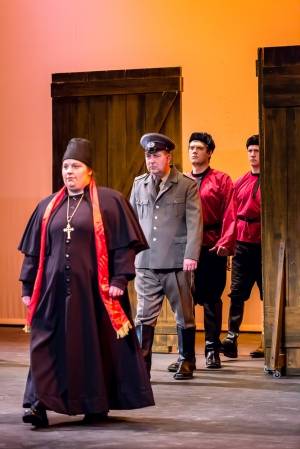 Brian Chaille’s variable performance as Wolf seemed to be the pattern of the evening. As Yente, Jaclyn Lowenstein got her laughs with her long-suffering complaints, but her delivery and gestures seemed to fit more with a New York bubbe from the 1980s than a turn-of-the-century widow. The constable, played by Gil Yohnka, silently conveyed imposing authority, but when he spoke, both his lack of mic and his difficulty with the accent undercut my ability to understand him.
Brian Chaille’s variable performance as Wolf seemed to be the pattern of the evening. As Yente, Jaclyn Lowenstein got her laughs with her long-suffering complaints, but her delivery and gestures seemed to fit more with a New York bubbe from the 1980s than a turn-of-the-century widow. The constable, played by Gil Yohnka, silently conveyed imposing authority, but when he spoke, both his lack of mic and his difficulty with the accent undercut my ability to understand him.
Technically, this production was also a mixed blessing. The set design was simple, clever, and well-executed. Five wooden panels recombined to create exteriors, interiors, and mixtures of the two. The dark wood stood out in contrast to brightly hued gels lighting up a solid screen during the day, or blended in with the darker swaths of night. The wooden cart was lovely and sturdy, a perfect prop for the staunch farmer. The sound system was not as sturdy, crackling and cutting out intermittently, or thumping against costumes. Only principal actors were mic’d, also, creating a volume differential during dialogue that was noticeably distracting. Cullyn Murphy, the orchestra’s conductor, did an excellent job watching during songs and adapting to singer’s deliveries, and the instrumentalists did a good job of following him.
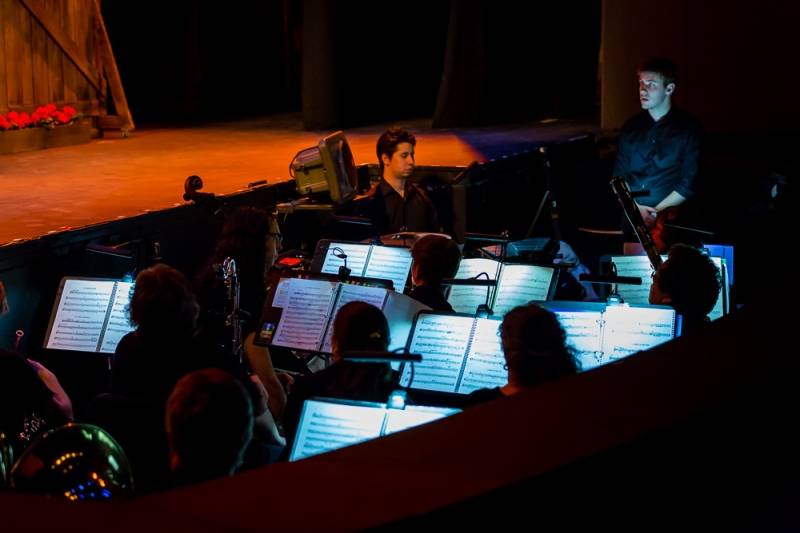
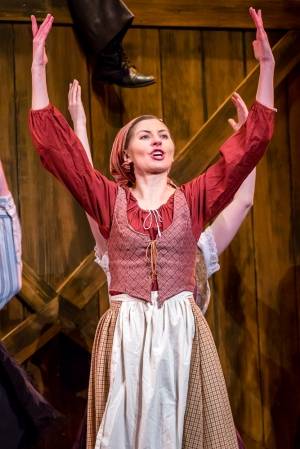 The choral work and dancing was well-executed, with simple movements easily performed by non-dancers and flourishes for the more skilled. Voices blended together pleasantly, although the mic situation put an emphasis on the primary characters. Most numbers resembled what I remember from the film, and “Tevye’s Dream” remains one of my favorite moments, with Malia Andrus bringing her own particular charm to Frumah-Sarah (in my humble opinion, the afterlife seems to have benefitted her sense of style). It was slightly disappointing to me, however, knowing why Jerome Robbins created the bottle dance, to see that it was performed with obvious artificial assistance. I’ve been to productions where it was replaced with another traditional Jewish dance rather than deciding between using stage-tricks or risking dancers’ safety, and I see no shame in making modifications to accommodate community dancers who are not Broadway-caliber daredevils.
The choral work and dancing was well-executed, with simple movements easily performed by non-dancers and flourishes for the more skilled. Voices blended together pleasantly, although the mic situation put an emphasis on the primary characters. Most numbers resembled what I remember from the film, and “Tevye’s Dream” remains one of my favorite moments, with Malia Andrus bringing her own particular charm to Frumah-Sarah (in my humble opinion, the afterlife seems to have benefitted her sense of style). It was slightly disappointing to me, however, knowing why Jerome Robbins created the bottle dance, to see that it was performed with obvious artificial assistance. I’ve been to productions where it was replaced with another traditional Jewish dance rather than deciding between using stage-tricks or risking dancers’ safety, and I see no shame in making modifications to accommodate community dancers who are not Broadway-caliber daredevils.
In the way that couples are said to grow to resemble each other, I felt as though repeated reproduction may have made the stage play begin to look like the movie. The familiarity may comfort most, but it’s not the reason I go to the theatre. No one has to re-invent the wheel, but the set designer and several of the actors excelled at bringing some unique stroke of personality or interpretation to a known entity, and I wish there had been more visible development in that direction.
Parkland Theatre’s production of Fiddler on the roof continues for another two weekends: April 22nd and 23rd at 7:30 p.m. with a Sunday matinee at 3 p.m. on April 24th; and April 28th-30th at 7:30 p.m. with a Sunday matinee at 3 p.m. on May 1st. All tickets are $16 with discounts available for seniors, students, youth, and groups. In addition, Thursday, April 28th is half-price night. Reservations can be made online, or by calling 217-351-2528 to reach the ticket office.
About Rebecca Knaur…
Editor of Smile Politely’s Arts section, rk makes a habit of drinking mind-altering beverages while writing opinions to be published. She has a highly developed sense of grammar and syntax, but little to no content filter. You can follow her on Twitter, @rknaur, but she rarely checks it, so feel free to reiterate tweets when you see her in person.
All photos by Scott Wells
Scott is a U.S. Navy veteran and a graduate of the University of Illinois. He has been a photographer and writer for Smile Politely since March of 2015.








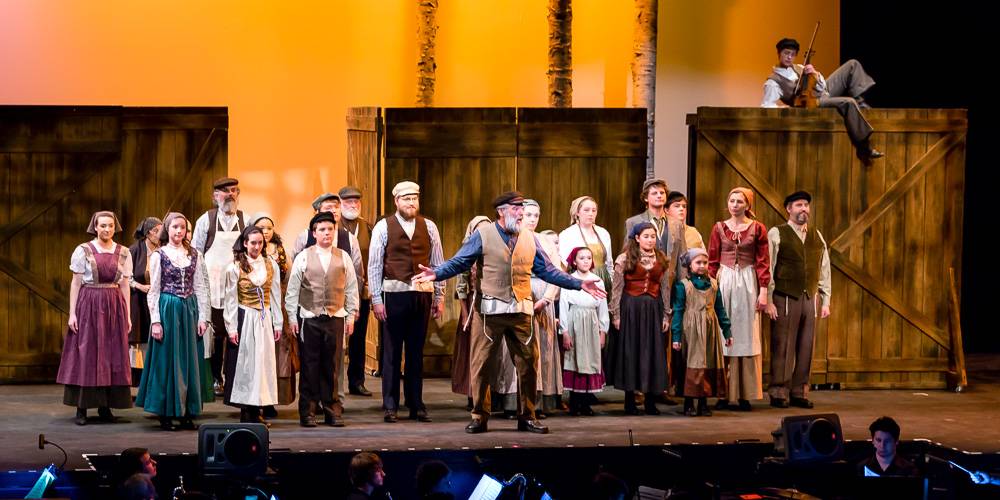
 About Rebecca Knaur…
About Rebecca Knaur… All photos by Scott Wells
All photos by Scott Wells